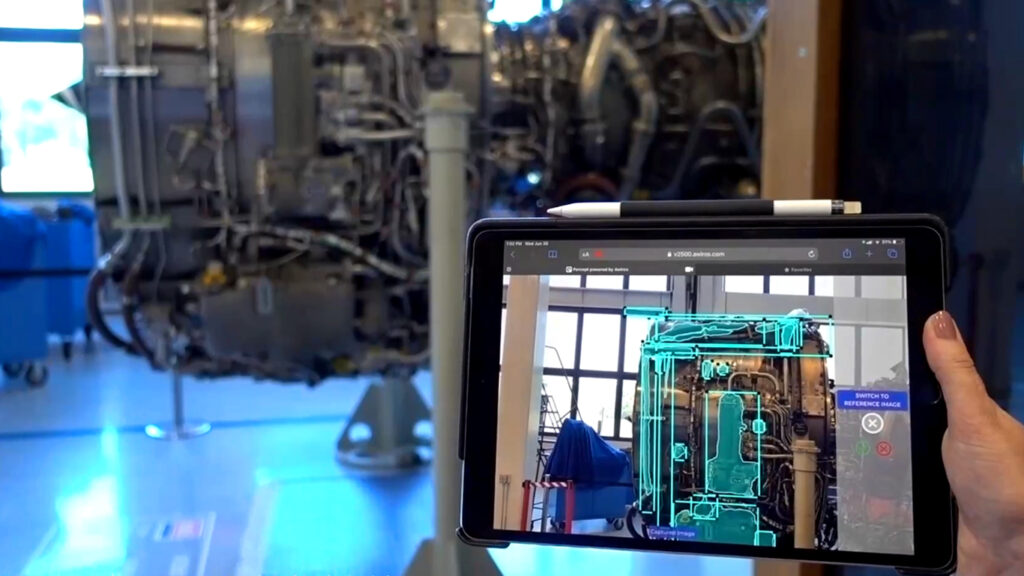
Pratt & Whitney and Awiros launched Percept, an AI-based aircraft engine inspection tool. Pictured above, Percept is being used to scan a V2500 engine on a mobile device. (Photo: Pratt & Whitney/Raytheon)
Pratt & Whitney has launched a new advanced aircraft engine monitoring tool that incorporates artificial intelligence that can provide maintenance personnel with real-time information on parts availability.
Called Percept, the system is a computer vision product that operates on the Awiros Video Intelligence operating system. Awiros is an Indian firm founded in 2015 specializing in computer vision, deep learning, and artificial intelligence (AI) applications.
The cloud-based computing system allows users to snap photos and video of aircraft engines on a mobile device and automatically receive detailed parts availability information, Pratt said in a statement.
Percept can enable faster and more cost-efficient turnaround of leased engines. Instead of an inspector having to examine an engine and check part-by-part, Percept automates engine inspections and can reduce the time it takes an inspector to perform the task by 90 percent, Pratt said.
Percept will be deployed exclusively on Pratt’s commercial engines, including the Pratt & Whitney GTF engine and the V2500.
“The Percept tool helps reduce time and effort involved in the pre-and-post lease analysis of aircraft engines,” said O Sung Kwon, Pratt’s Vice President of Customer Support. “We have been working with Awiros, an Indian Computer Vision and Artificial Intelligence (AI) start-up for the past few years to mature this technology; we are excited to be shifting from technology development to now bringing an operational product to the market.”
Awiros was selected as the winner of the RTX Innovation Challenge, an Indian competition launched in September 2019 with more than 60 Indian and global startups working in computer vision, AI, and machine learning. The teams proposed solutions to optimize and automate aircraft engine inspections with reduced human interventions. Awiros’ idea was evaluated through 2021 and is expected to be launched commercially later this year.
“Building the Percept tool in collaboration with RTX has been one of the most exciting opportunities in the journey of Awiros as a startup,” said Vikram Gupta, founder and chief executive of Awiros. “We are proud that Percept’s high-fidelity scanning of Pratt & Whitney engines with handheld [mobile] phones, without any specialized hardware, is being commercially deployed in the aerospace industry.”
India is the fastest-growing aviation industry in the world and a focal point for aviation technological innovation, said Ashmita Sethi, president and India country head for Pratt & Whitney.
“Percept is the result of some of India’s best and brightest minds collaborating with Pratt & Whitney to innovate a solution that delivers significant efficiencies and value to our customers,” Sethi said.
This week, RTX shared news of the progress made by Pratt & Whitney and Collins Aerospace on advancing hybrid-electric propulsion through the Scalable Turboelectric Powertrain Technology (STEP-Tech) demonstrator. The STEP-Tech demonstrator completed its first engine run and electrical system integration test, the company announced on June 20. It’s a modular and scalable demonstrator platform that can be used to rapidly prototype distributed propulsion concepts for high-speed eVTOL aircraft, blended wing body aircraft, and other kinds of advanced air mobility vehicles.
RTX also announced this week that the team reached an important milestone in its hybrid-electric flight demonstrator program. A rated power test of the demonstrator’s 1MW electric motor—developed by Collins Aerospace—was completed successfully. As part of a hybrid-electric propulsion system, the 1MW motor will be combined with an efficient thermal engine developed by Pratt & Whitney.
Early last year, Pratt & Whitney was awarded a DoE project for the advancement of hydrogen propulsion technology. The company also successfully completed a test on its GTF Advantage engine configuration involving the use of 100% sustainable aviation fuel.